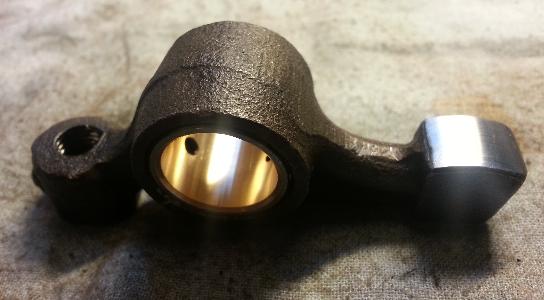The MGA With An Attitude
REFINISHING ROCKER ARM Output End - CH-200
At 11:26 PM 2/7/2007 -0700, Francis Camilleri in Malta wrote:
>".... when inserting the feeler gauge to set the gaps the feeler blade was getting a little grooved. This seemed to be happening because the rocker head was not flat on the valve stem surface but was resting on its outer edge. Do you think this would cause any problems, like for instance noisy tappets?"
The output and of the rocker arm is worn on the end where it contacts the valve stem. This leave a depression with ridges at the sides that interfere with use of the feeler gauge. Result of adjustment then leaves a gap too large. The proper repair would be to have the tips of the arms re-ground to the proper smooth arc.
You can do this with a drill press and a small grinding wheel on an arbor. Mount the grinding wheel in the drill press to be run at high speed for grinding. Place the rocker shaft assembly on the drill press work table, resting the bottom of the pedestals on the table. Rotate the rocker arm on the shaft to position the arm upside down with the output end under the flat side of the grinding wheel. Place one finger on the input end of the arm and apply a little downward pressure to bring the output end into contact with the wheel. Work the drill press spindle up and down with the wheel against the output end of the rocker arm to move the arm through the normal range of working motion (or a bit more motion) while the grinding wheel dresses the working surface to a smooth arc.

Photo compliments of Lars Christiansen
You can also do this with a bench grinder. Place an angle block or a short section of large angle iron on the steady rest. Stand the rocker shaft assembly on end and clamp one of the rocker pedestals to the angle block. This will position the rocker shaft parallel to the side of the grinding wheel. Position the output end of the rocker arm against the flat side of the wheel, apply a small pressure for grinding. Move the angle block left to right across the steady rest to move the arm through the normal range of working motion (or a bit more motion) while the grinding wheel dresses the working surface to a smooth arc.
If you wish to run the engine immediately without regrinding the rocker arms, there are a couple of ways to adjust for the proper working clearance without using a feeler gauge.
You could use a ClickAdjust tool, which I don't particularly like, and which you don't need, but you can see it here: "ClickAdjust" -- TS-080
You can do exactly the same adjustment quickly without the special tool. See Valve Adjustment Without a Feeler Gauge -- CH-106
The rocker arms will make some noise that you can clearly hear with engine running and the bonnet open. It will sound like eight little sewing machines running at the same time. With the bonnet closed you will not hear much of this noise from the passenger compartment, and what you do hear you will come to ignore or enjoy as part of the vintage car experience.
|
